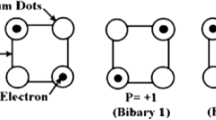Abstract
One of the novel technologies in the implementation of digital circuits is Quantum-Dot Cellular Automata (QCA) nanotechnology. This technology, which has been introduced over two decades ago, can be a great alternative to today’s CMOS chips. The main advantages of this technology include low occupation area and ultra-low power consumption. This paper presents an effective design and arrangement of one of the methods of pseudo random bit generator which is called linear feedback shift register (LFSR) in the technology of quantum cellular automata. In this research, using the D-latch and level to edge converter, a flip-flop is designed. The proposed D flip-flop and an XOR gate are used to design three new LFSR circuits in QCA technology. The simulation results show that the proposed designs have stable and useful structures in terms of area, latency and complexity. Simulations show that the first proposed 3-bit pseudo random code design has 233 cells, 4 clock delay cycles, and 0.27μm2 occupied area while the second proposed 3-bit design has 175 cells, 4 clock delay cycles, and 0.23 μm2 occupied area. In addition, the third proposed 3-bit LFSR has 188 cells, latency of 4 clock cycle and occupied area of 0.24 μm2. Power analysis are done for all of the designs.





























Similar content being viewed by others
References
Shamsabadi, A.S., Ghahfarokhi, B.S., Zamanifar, K., Movahedinia, N.: Applying inherent capabilities of quantum-dot cellular automata to design: D flip-flop case study. J. Syst. Archit. 55(3), 180–187 (2009)
Deng, F., Xie, G., Zhang, Y., Peng, F., Lv, H.: A novel design and analysis of comparator with XNOR gate for QCA. Microprocess. Microsyst. 55, 131–135 (2017)
Roshan, M.G., Gholami, M.: 4-Bit serial shift register with reset ability and 4-bit LFSR in QCA technology using minimum number of cells and delay. Comput. Electr. Eng. 78:449–62 (2019 Sep 1)
Ke-ming, Q, Yin-shui, X.: Quantum-dots cellular automata comparator. In ASIC, 2007. ASICON'07. 7th International Conference on 2007 Oct 22, pp. 1297–1300. IEEE
Zoka, S., Gholami, M.: A novel rising edge triggered resettable D flip-flop using five input majority gate. Microprocess. Microsyst. 61, 327–335 (2018)
Roshan, M.G., Gholami, M.: Novel D latches and D Flip-flops with set and reset ability in QCA nanotechnology using minimum cells and area. Int. J. Theor. Phys. 57(10), 3223–3241 (2018)
Ahmad, F., Mustafa, M., Wani, N.A., Mir, F.A.: A novel idea of pseudo-code generator in quantum-dot cellular automata (QCA). Int. J. Simul. Multidiscip. Des. Optim. 5, A04 (2014)
Beigh, M.R., Mustafa, M.: Novel linear feedback shift register design in quantum-dot cellular automata. Indian J. Pure Appl. Phys. 52(3), 203–209 (2015)
Kumar, D., Mitra, D.: Design of a practical fault-tolerant adder in QCA. Microelectron. J. 53, 90–104 (2016)
Abutaleb, M.M.: A novel configurable flip flop design using inherent capabilities of quantum-dot cellular automata. Microprocess. Microsyst. 56, 101–112 (2018)
Amirzadeh, Z., Gholami, M.: Counters designs with minimum number of cells and area in the quantum-dot cellular automata technology. Int. J. Theor. Phys. 58(6):1758–75 (2019 Jun 15)
De, D., Purkayastha, T., Chattopadhyay, T.: Design of QCA based programmable logic Array using decoder. Microelectron. J. 55, 92–107 (2016 Sep 1)
Rao, N.G., Srikanth, P.C., Sharan, P.: A novel quantum dot cellular automata for 4-bit code converters. Optik. 127(10), 4246–4249 (2016)
Erniyazov, S., Jeon, J.C.: Carry save adder and carry look ahead adder using inverter chain based coplanar QCA full adder for low energy dissipation. Microelectron. Eng. 211:37–43 (2019 Apr 15)
Campos, C.A., Marciano, A.L., Neto, O.P., Torres, F.S.: Use: a universal, scalable, and efficient clocking scheme for QCA. IEEE Trans. Comput. Aided Des. Integr. Circuits Syst. 35(3), 513–517 (2016)
Abutaleb, M.M.: Robust and efficient quantum-dot cellular automata synchronous counters. Microelectron. J. 61, 6–14 (2017)
Das, J.C., De, D.: Operational efficiency of novel SISO shift register under thermal randomness in quantum-dot cellular automata design. Microsyst. Technol. 23(9), 4155–4168 (2017)
Sasamal, T.N., Singh, A.K., Ghanekar, U.: Design of QCA-based D Flip flop and memory cell using rotated majority gate. In: Smart Innovations in Communication and Computational Sciences, pp. 233–247. Springer, Singapore (2019)
Hashemi, S., Navi, K.: New robust QCA D flip flop and memory structures. Microelectron. J. 43(12), 929–940 (2012)
Taherkhani, E., Moaiyeri, M.H., Angizi, S.: Design of an ultra-efficient reversible full adder-subtractor in quantum-dot cellular automata. Optik. 142, 557–563 (2017)
Srivastava, S., Asthana, A., Bhanja, S., Sarkar, S.: QCAPro-an error-power estimation tool for QCA circuit design. In: Circuits and Systems (ISCAS), 2011 IEEE International Symposium on 2011 May 15, pp. 2377–2380. IEEE
Author information
Authors and Affiliations
Corresponding author
Additional information
Publisher’s Note
Springer Nature remains neutral with regard to jurisdictional claims in published maps and institutional affiliations.
Rights and permissions
About this article
Cite this article
Amirzadeh, Z., Gholami, M. Analysis and Design of the Pseudo-Random Bit Generator in the Technology of Quantum-Dot Cellular Automata. Int J Theor Phys 59, 29–48 (2020). https://doi.org/10.1007/s10773-019-04262-w
Received:
Accepted:
Published:
Issue Date:
DOI: https://doi.org/10.1007/s10773-019-04262-w




